We were relieved that we had built close to the middle of the itinerary some time just to hang out. As you know if you’ve been reading most posts, we keep up a pretty active schedule; some would no doubt say, a very active one.
That was why we decided to while away some time at the fish market as we'd enjoyed our time there yesterday so much. Our walk down to the market was past some pretty ugly homes. I was surprised how so much of Puerto Ayora, the main town in all of the Galapagos, was remarkably unattractive since it's such a major tourist destination.
It was fun to be at the fish market again even if there were more tourists watching the animals’ antics than people buying the morning's catch!
We had heard wonderful things about the fabulous beach at Tortuga Bay located about three kilometers southwest of Puerto Ayora so we headed that way.
At the foot of the hill before the start of the path to Tortuga Bay was the Centro Communitaria Ambiental Miguel Cituente Arias, a long name for a center studying conservation efforts and issues in the waters around the archipelago.
A long boardwalk, built through the bush, took us down to Turtle Bay. Walking through shady but low trees with many varieties of cactus was very pleasant.
We couldn't get lost as long as we followed these signs!
The check in station and, more importantly, the last chance for a bathroom break until we returned!
More of the opuntia cactus we'd seen yesterday.
A slow picture day if I am taking a photo of a cricket!
The sign on Steven's left warned of the strong currents at the first beach, Playa Brava.
We saw only two other people on the mammoth white sandy beach that seemed to stretch on forever. We've never seen such a huge beach nor one as empty either!
In the low lying brush right by the water's edge, we discovered we had some more company after all, but they were marine iguanas, not people!
The marine iguanas are endemic to the Galapagos and the only modern lizard that reminds people of dinosaurs and mythical creatures like dragons. The iguanas are so often immobile and blend in with the rocks so well, they almost disappear from our eyes.
We laughed and said there should be a sign saying Marine Iguanas Crossing! They were on their way to a nesting area.
National Geographic wrote that the much-maligned marine iguanas of the Galapagos Islands are so famously homely, even Charles Darwin described them as "hideous-looking" and "most disgusting, clumsy lizards."
There was a sign notifying people to stay at least two meters away from the iguanas and not to touch or disturb them. That was easier said than done because there was a constant parade of them between us and the next beach where we were headed!
We marveled how lucky we were to be at the only place in the world to see marine iguanas in the wild. It was a surreal site with hordes of marine iguanas stomping the length of the beach.
It was so hard to tear ourselves away from the iguanas but we the lure of another beach proved finally to be a bigger draw.
Lava rocks where the iguanas are often found:
Ahh, lucky us - more cactus to traipse through before THE beach at Tortuga Bay!
Nestled in some rocks was our first blue-footed booby sighting! We were thrilled to bits to see one as it was totally unexpected. We were excited as all get out after hearing all about them and seeing every souvenir shop in town sell t-shirts, aprons, etc with their likeness.
I'll tell you more about the remarkable birds in a later post.
After a good long hike, we finally arrived at Tortuga Bay.
A tour boat came and disgorged its passengers where we had earlier seen the lone blue-footed booby.
Because we walked back at high tide, there was just a narrow spit of land to walk on back to the path about 4:30.
Thank goodness, we had left when we did because a huge number of what looked like middle school students were just getting to the beach!
The wonder of nature to see so much vegetation growing amid the volcanic rocks.
The pads and fruits of the opuntia species of cactus are an important source of food for both iguanas and tortoises. Cactus finches also rely on its fruits, seeds and flowers.
The undergrowth on both sides of the path was such unforgiving terrain and so impassable and inhospitable.
Back near the harbor, we observed people playing cricket, a game very popular in and associated with Britain and in the countries of the former British Empire:
From the interesting food packaging department: Bags of eggs,
garbage cans of rice and flour:
and bags of shampoo!
That was why we decided to while away some time at the fish market as we'd enjoyed our time there yesterday so much. Our walk down to the market was past some pretty ugly homes. I was surprised how so much of Puerto Ayora, the main town in all of the Galapagos, was remarkably unattractive since it's such a major tourist destination.
It was fun to be at the fish market again even if there were more tourists watching the animals’ antics than people buying the morning's catch!
We had heard wonderful things about the fabulous beach at Tortuga Bay located about three kilometers southwest of Puerto Ayora so we headed that way.
At the foot of the hill before the start of the path to Tortuga Bay was the Centro Communitaria Ambiental Miguel Cituente Arias, a long name for a center studying conservation efforts and issues in the waters around the archipelago.
A long boardwalk, built through the bush, took us down to Turtle Bay. Walking through shady but low trees with many varieties of cactus was very pleasant.
We couldn't get lost as long as we followed these signs!
The check in station and, more importantly, the last chance for a bathroom break until we returned!
More of the opuntia cactus we'd seen yesterday.
A slow picture day if I am taking a photo of a cricket!
A sign advised us to stay clear of the manzanilla tree because of its poisonous fruit and harmful bark.
We had been hearing the sound of the water for a long time so finally seeing it in the distance was so marvelous. The sign on Steven's left warned of the strong currents at the first beach, Playa Brava.
We were so happy to run into Nadine and Oliver, our friends from Luxembourg, whom we had hiked with in Cuenca a few days earlier. They were just leaving as we arrived unfortunately but we had a nice chat with them before bidding them adieu once again.
Even though the red flag was up cautioning people not to swim at the first beach, we saw some surfers that looked like they were having fun.We saw only two other people on the mammoth white sandy beach that seemed to stretch on forever. We've never seen such a huge beach nor one as empty either!
In the low lying brush right by the water's edge, we discovered we had some more company after all, but they were marine iguanas, not people!
The marine iguanas are endemic to the Galapagos and the only modern lizard that reminds people of dinosaurs and mythical creatures like dragons. The iguanas are so often immobile and blend in with the rocks so well, they almost disappear from our eyes.
That is, until they snort and therefore release excess salt from their bodies. Their apparent impassiveness is a strategy to recover the energy lost in the cold sea water and take advantage of the hot lava rocks.
I read that iguanas protect each other, guard themselves and give each other warmth so closely that they can look like one whole being!We laughed and said there should be a sign saying Marine Iguanas Crossing! They were on their way to a nesting area.
National Geographic wrote that the much-maligned marine iguanas of the Galapagos Islands are so famously homely, even Charles Darwin described them as "hideous-looking" and "most disgusting, clumsy lizards."
There was a sign notifying people to stay at least two meters away from the iguanas and not to touch or disturb them. That was easier said than done because there was a constant parade of them between us and the next beach where we were headed!
It was so hard to tear ourselves away from the iguanas but we the lure of another beach proved finally to be a bigger draw.
Ahh, lucky us - more cactus to traipse through before THE beach at Tortuga Bay!
Nestled in some rocks was our first blue-footed booby sighting! We were thrilled to bits to see one as it was totally unexpected. We were excited as all get out after hearing all about them and seeing every souvenir shop in town sell t-shirts, aprons, etc with their likeness.
I'll tell you more about the remarkable birds in a later post.
After a good long hike, we finally arrived at Tortuga Bay.
Probably because the weather was a little chilly to go swimming, there weren’t many people on the beach.
We saw a few brave souls swim for a few minutes and a few more had rented kayaks from the vendor down the beach a way. That looked way too ambitious for us right then! Chris: I am sure you and John would probably have found this a perfect place to kayak!
What an ingenious idea having ‘clothes trees’ on the beach so people could hang up their things out of reach of curious animals.
We were more than content after the walk to get there to just be beach bums and read our kindles. It was a natural park without amenities or facilities so were glad we had taken water and snacks to the very secluded beach. Little finches constantly jumped over our feet and hopped on our hands thinking we had some morsels for them!
The clothes tree a little later in the day when more people arrived!
Because we walked back at high tide, there was just a narrow spit of land to walk on back to the path about 4:30.
Thank goodness, we had left when we did because a huge number of what looked like middle school students were just getting to the beach!
The wonder of nature to see so much vegetation growing amid the volcanic rocks.
The pads and fruits of the opuntia species of cactus are an important source of food for both iguanas and tortoises. Cactus finches also rely on its fruits, seeds and flowers.
The undergrowth on both sides of the path was such unforgiving terrain and so impassable and inhospitable.
From the interesting food packaging department: Bags of eggs,
garbage cans of rice and flour:
and bags of shampoo!
What a totally relaxing day it had been eyeing the resident seal and pelicans at the market, enjoying a solitary hike to Tortuga Bay, being entranced by so many marine iguanas and finally zoning out on a beach in paradise.
Next post: Magnificent frigates and blue-footed boobies on North Seymour Island.
Posted on November 13th, 2017, from Sucre, Bolivia.





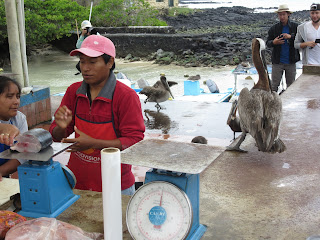











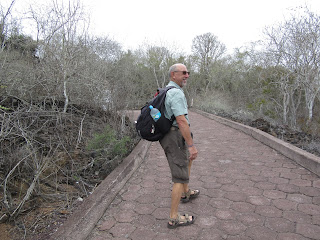












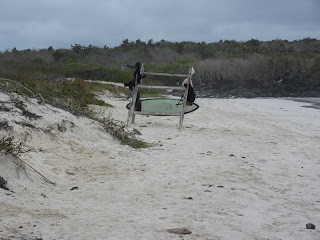

















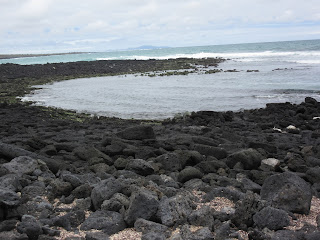









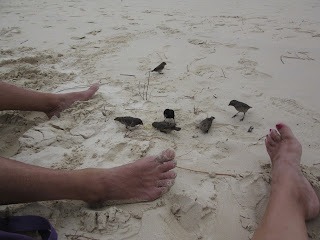
























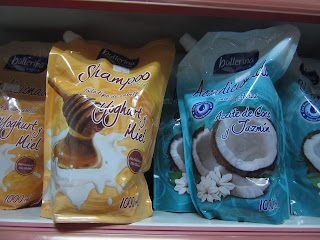
No comments:
Post a Comment